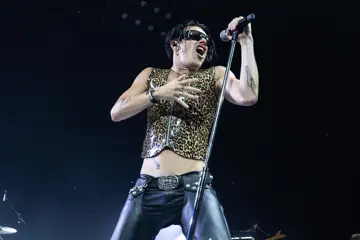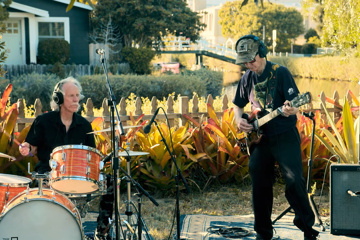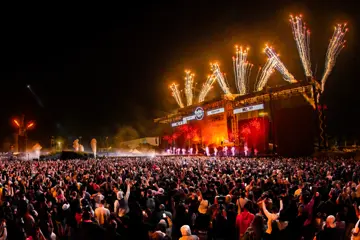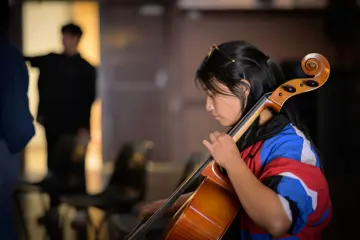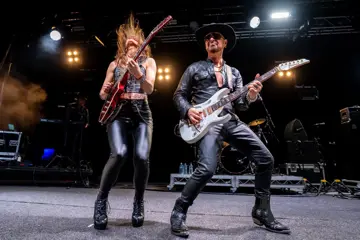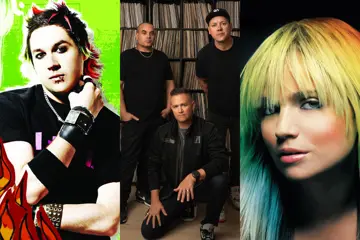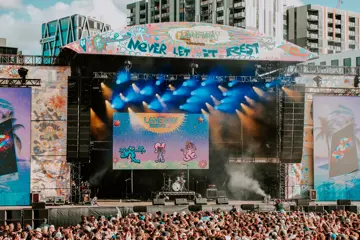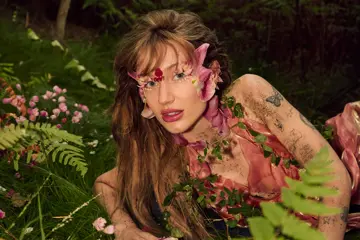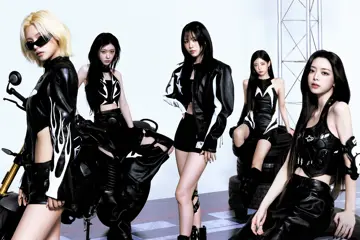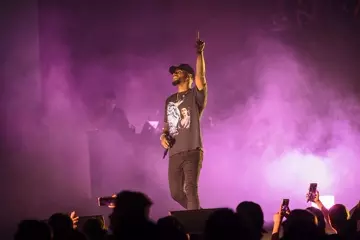 Hoodoo Gurus
Hoodoo Gurus“You can’t bury love; you’ve gotta dig it up.” So sang Dave Faulkner on the Hoodoo Gurus’ debut album, Stoneage Romeos, which was released 40 years ago this week.
So, what would a rock archaeologist find if they discovered this record?
Well, track one, side one, (Let’s All) Turn On, sets the scene. The album opens with a musical manifesto:
“Shake Some Action, Psychotic Reaction/ No Satisfaction, Sky Pilot, Sky Saxon/ That’s what I like, that’s what I like/ Blitzkrieg Bop to the Jailhouse Rock/ Stop Stop/ At the Hop, do the Bluejean Bop/ That’s what I like.”
Even if you’d never heard of the Hoodoo Gurus, after hearing the first 30 seconds of their first album, you’d know what they were all about.
The band had formed three years earlier, on New Year’s Day 1981 – as Le Hoodoo Gurus. Faulkner had actually tentatively started a band called the Gurus when he was still in Perth, where he wrote Tojo, which would later turn up on Stoneage Romeos.
“It just didn’t seem right,” he notes. “And the name ‘the Gurus’ just didn’t seem like it was enough.”
Enter guitarist Roddy Radalj. He dug a Johnny Thunders tune called Who Do Voodoo, and when Faulkner said “Gurus”, Radalj suggested “Hoodoo Gurus”.
The other founding guitarist, Kimble Rendall, added the “Le”, which the band dropped after releasing their debut single, Leilani.
The first Le Hoodoo Gurus line-up was Faulkner, Rendall and Radalj. Drummer James Baker, ex-Scientists, who had played with Faulkner in Perth punk band The Victims, joined a few months later.
Don't miss a beat with our FREE daily newsletter
“We didn’t actually play a gig until September 1981,” Faulkner explains. “We only rehearsed at weekends. It really started as a bit of a hobby, but then it became obvious we had something a bit more serious going on, and it just snowballed from there.”
The band’s first gig was at Sydney’s Institute of Technology, now the University of Technology, on September 4, 1981. “We were pretty terrible,” Faulkner laughs. The Gurus played in the basement of the cafeteria. In the crowd was guitarist Brad Shepherd, who joined the band the following year.
The band’s first-ever appearance was actually on TV – on Channel 10’s much-loved afternoon show Simon Townsend’s Wonder World!, which also provided INXS with their TV debut. “We taped the show about six weeks before our first gig.” Rendall (who went on to direct the slasher cult classic Cut, starring Kylie Minogue and Molly Ringwald) knew a few people at the show.
Townsend and his pet bloodhound, Woodrow, introduced the story by Angela Catterns, depicting how a band gets started in the music business. “It didn’t really have much educational value,” Faulkner smiles. “We just looned around to a demo we’d done, which was so bad, we didn’t let them hear it until the last minute when it was too late to cancel the story.”
The band’s next TV appearance was backing a singing dog named Molly on The Don Lane Show.
As Le Hoodoo Gurus, the band toured with the now-disgraced Gary Glitter. “It was the original Glitter Band,” Faulkner recalls, “so we were pretty chuffed. I’m a big fan of that music and that glam era. But Gary was displaying some weirdness even then, though certainly not what he was later convicted of.”
The singer remembers that Glitter insisted his son pretend it was his 21st, so the promoters would throw him a big party. It was his 18th birthday. “It was a good scam,” Faulkner chuckles.
After releasing Leilani on Phantom Records, the Gurus signed to Big Time Records, a label set up by Air Supply’s managers Fred Bestall and Lance Reynolds.
When their debut album was released, the band’s manager at the time, music journalist Stuart Coupe, said they were “a curious mixture of rockabilly, Merseybeat, psychedelia, glitter, punk and straight pop”.
The Gurus performed the album’s second single, Tojo, on Countdown.
Dave Faulkner doesn’t have particularly fond memories of the band’s appearances on the legendary music show. “Countdown was must-watch TV. As far as when we were on it, it was always a bit strange – you had all these angry 13-year-old girls who just give you crap. They just wanted to see John Paul Young or something; whatever it was, it wasn’t the Hoodoo Gurus. We just had to go out there and pretend they didn’t exist – as they did for us.”
The band’s third single, My Girl, became their first Top 40 hit – and fuelled one of the biggest misconceptions about the Hoodoo Gurus. Because of the music video, most people think the song is about a greyhound. It’s not.
“It’s actually a song I wrote for a little made-up home movie that I wanted to do, like a send-up of the Gidget movies, called Gidget Goes Ape,” Faulkner reveals. “My Girl was the song that Gidget was going to listen to on the beach through her little transistor radio. So it was a tribute to ’60s pop ballads.”
As for the clip, shot at Harold Park in Sydney, it features a greyhound named Defiant Lee. “That dog was a champion. All those trophies you see in the video were real – from that one dog. It was incredible.”
Stoneage Romeos – its title inspired by The Three Stooges’ 1955 short film Stone Age Romeos – was dedicated to characters from classic TV shows: Larabee (Get Smart), Corporal Randolph Agarn (F Troop) and Arnold Ziffel (the pig in Petticoat Junction). And a classic Get Smart episode, “The Groovy Guru”, inspired the lyric of In The Echo Chamber.
In the US, Stoneage Romeos was released by A&M Records, who inexplicably changed Yanni Stumbles’ distinctive cover artwork. But the album was still a success, spending four weeks on top of the US College charts and peaking at #209 on the Billboard charts, as well as cracking the Top 40 in Sweden and New Zealand.
In Australia, Stoneage Romeos reached #29 and won Best Debut Album at the Countdown Awards, beating Pseudo Echo’s Autumnal Park.
In 2008, AIR – the Australian Independent Record Labels Association – came up with a list of the top 50 indie albums after consulting industry figures, and then the public voted for their favourites. My buddy Neil Rogers – community radio legend and host of 3RRR’s The Australian Mood – placed Stoneage Romeos at number one. In the overall poll, it came in at number three, just behind The Triffids’ Born Sandy Devotional and The Saints’ (I’m) Stranded.
Two years later, Stoneage Romeos landed at #28 in The 100 Best Australian Albums. “Hoodoo Gurus had the perfect aesthetic, pedigree and songs – no band on the planet looked cooler (balancing paisley, buckskin and punk/goth stylings) or rocked better, harder, smarter,” the authors stated.
“The impact and influence that the album and Hoodoo Gurus have had on the Australian music landscape cannot be overstated. The band is revered by almost every Australian guitar band that followed after them.”
I once asked one of Sydney’s finest songwriters, Paul Andrews – the lead singer of Lazy Susan and Family Fold – to nominate his favourite Aussie album. “A choice between Midnight Oil’s 10-1, Hoodoo Gurus’ Stoneage Romeos and Hunters & Collectors’ Human Frailty,” he replied. “I think I’ll go with the Gurus. I mean, I Was A Kamikaze Pilot! The lyrics in that, just incredible.”
Twenty-one years after Stoneage Romeos was released, Jason Evans, the creator of the much-loved charity football game the Community Cup, curated a tribute album, Stoneage Cameos, featuring You Am I, Spiderbait, The Living End, Grinspoon, Even and Dallas Crane.
Faulkner dug the tribute. “In some ways, I found that honour a bit more impressive than the Hall of Fame because it was other bands tipping their hats and risking their own reputations doing our songs. And they did such great versions.”
When I asked Faulkner if he had a favourite cover of a Gurus song, he replied, “I’ve got a least-favourite.” He cited Simon F’s version of I Want You Back, featuring Steve Stevens on guitar, and Holly Knight – who co-wrote Pat Benatar’s Love Is A Battlefield and Tina Turner’s The Best – on piano. “Very much a non-hit wonder. It’s pretty appalling.”
Faulkner famously said: “Some writers refer to their creations as their ‘children’; well, this felt more akin to having your child grow up to be a serial killer.”
Dave Faulkner and Brad Shepherd are the last Gurus standing from the Stoneage Romeos sessions. Bass player Clyde Bramley left after the third album, while drummer James Baker controversially departed a few months after the first album was released and just before the band headed to America.
Stuart Coupe delivered the news to the drummer. “Baker was gutted and, given that he was clearly the most loved member of the Hoodoo Gurus, the 237 people in the inner-city scene that actually gave a shit suddenly decided that the band were nothing more than calculated, cold and career-orientated,” Coupe recounted in his 2023 memoir Shake Some Action.
“Personally, I really adored Baker, couldn’t tell if he was a great or ordinary or terrible drummer and couldn’t care less. I still loved the Hoodoo Gurus, but with his departure went a big part of the spirit and soul of what made them great in the first place.”
Baker was replaced by Mark Kingsmill, brother of long-time Triple J music director Richard Kingsmill.
Stoneage Romeos was released the week of James Baker’s 30th birthday. Now 70, Baker is releasing his debut solo album, Born To Rock. Sadly, it will be his final release – he has terminal cancer.
Produced by Alan Thorne (who also helmed Paul Kelly’s breakthrough, Gossip), Stoneage Romeos broke the Hoodoo Gurus nationwide, as James Baker focused his attention on his other band, Beasts of Bourbon. The album even included a song that name-checked one of Melbourne’s most famous venues. “I can’t recall when we first started to break through in Melbourne, but it was something we’d always aimed for,” Faulkner explains. “I mean, we wrote a song deliberately mentioning a Melbourne landmark, a song called Arthur.”
The song is the tragic tale of a taxi driver, who “played the bass” and “had an angel’s face”. His untimely demise came when “a black gelato van, finished for the day, met with Arthur’s taxi head-on down St. Kilda way, by the Prince of Wales.”
“We ended up playing the Prince of Wales, and that became a big song when we played there. We actually deliberately mentioned the Prince of Wales and St Kilda because we wanted to play in Melbourne and play at the Prince, so that was a way of making some sort of wish fulfilment.”
So, 40 years on, how does Dave Faulkner look back on Stoneage Romeos?
“It’s funny that people call it a classic now. At the time, it was hardly ballyhooed with much fervour. The reviews were fairly mild, and the sales weren’t rapid. It just grew in stature over the years.”
In 1984, Clinton Walker gave the record a mixed rave in Rolling Stone. “While it’s muscular and coherent, it’s neither searing nor really inspired,” he opined. “Mainly it serves as an appetizer for a second album.”
“When we got signed up, people never thought we’d make a serious go of anything,” Faulkner believes. “They thought we were a bit of a joke.
“The sort of bands the Australian industry were championing were nothing like what we do. We were a bit alternative, a bit idiosyncratic, not trying to copy every latest overseas trend, we just did our own thing. I think that’s the only way to go – whatever era you’re in.
“But at the time it was very unpopular what we were doing. We were supposed to sound like Pseudo Echo or something like that, the latest synth-pop thing.”
When Stoneage Romeos was released, Dave Faulkner rejected the notion that the Gurus were ’60s revivalists. “We don’t want to be seen to be waving some sort of psychedelic or ’60s punk banner because that really isn’t what we’re about,” he said. “We’re definitely not on a crusade for any sort of music, and it annoys me when people suggest we are. I maintain that our blend of influences is pretty seamless. We’re not revivalists. We have no interest in fitting into other people’s bags.”
Indeed, Stoneage Romeos revealed a band that wasn’t stuck in the ’60s – they were in their own glorious time zone.
And how could you not love a band that sang, “Who wears short shorts? We wear short shorts!”
That’s what I like. Turn on.


